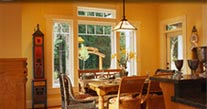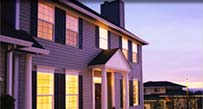Sound Deadening: A lesson on STC scores, coating, and sound attenuation
Source Post: http://www.replacement-windows.com/windowbb/viewtopic.php?t=2186A single 1/4" laminated lite consisting of 1/8" glass / .030 pvb interlayer / 1/8" glass will get you an STC rating of 35.
Since we all know that an IG is better at blocking sound than is a single lite; we mount this 1/4" laminated lite into an IG consisting of an 1/8" outer lite and a 1/4" airspace and we end up with an overall STC rating of....35.
There's a head scratcher.
What happened is that the narrow (1/4") airspace actually negated the potential sound attenuation advantage of adding a second lite to the original lami lite. If we were to increase the airspace to 3/8", we get an STC of 36. Increase to 1/2" airspace and we increase the STC to 37.
None of which really answers any question, but it is interesting, I think anyway.
But to answer a question...
As mentioned, 1/8" / .030pvb / 1/8" lami has an overall STC of 35. If we increase the interlayer to .060, then we get an overall STC of...35.
Again we have a head scratcher.
So what happens if we jump the interlayer to .090? Well, we now have a product that may be suitable for use in a hurricane impact area, but we really haven't done much to increase the sound attenuation performance.
Stopping unwanted sound thru any material is determined by three things – mass, stiffness, and damping. Laminated glass improves the damping performance of the unit by squeezing that softer interlayer material between the two outer solid and much more dense glass lites. The primary advantage of laminated glass is the change in density as sound penetrates the material rather than the thickness of the interlayer material.
And as an aside, there are PVB interlayer formulations that have improved sound-blocking performance versus "ordinary" PVB.
Trosifol (a European manufacturer of PVB) claims that their PVB has better sound-blocking performance than other products and they market their interlayer material as such.
Solutia, probably the largest manufacturer of PVB in the world, markets a "sound control" PVB as well as "regular" PVB. Typically the sound performance products have some advantage in certain frequency ranges and possibly a point or two advantage in overall performance.
Curiously, sound performance PVB products seem to be more commonly used in Europe - but then Europeans tend to use a good bit more laminated glass in their buildings than we do in North America in any case.
My daughter and I are in the process of building a home for her. The windows that I spec'd and that we installed in her home are tilt/turn, triple pane with 4mm outer lites with a 3mm center lite and 7/16" airspace between the lites - dual LowE (surfaces 2 and 5) and argon filled. T
These windows have U-factor of .16 on the fixed units and .21 on the operators; but the point here is that these windows are really quiet because of the construction - a by product really - but a nice added value.
I don't know that this make-up has ever been specifically STC rated by the window manufacturer, but I would suspect an STC value of about 38 or so...maybe a little better...
And btw, these things were freaking heavy!!!!!
One very common misconception is that car windshields are laminated tempered glass. Actually, windshields are laminated annealed glass that use a lower adhesion (versus architectural or residential grade) interlayer in their construction.
In a collision between a forehead and a windshield something is going to break. By design, we would much prefer it to be the windshield and not the forehead (or neck, etc). Windshield's are manufactured using a lower adhesion interlayer to produce what is called a "controlled delamination" in the event of a collision.
Basically, the weaker bond between the glass and the interlayer allows the glass to "slip" as the windshield is broken by the impact and the interlayer will then stretch like a balloon absorbing the impact of the victim's forehead - hopefully saving the person's life.
A tempered windshield would be much less likely to break in a collision with a forehead and as a result the victim would be more likely to have serious or fatal injuries as a result.
Source Post: Another noise reduction question
http://www.replacement-windows.com/windowbb/viewtopic.php?t=2186
Posted: Thu Feb 14, 2008 8:50 pm




 Call us at
Call us at


